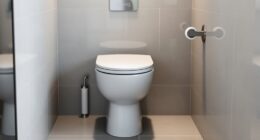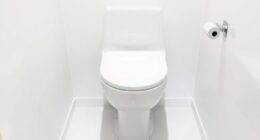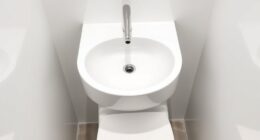Have you ever pondered why mold forms on your bathroom ceiling? We’re here to illuminate this annoying problem.
High humidity levels, inadequate ventilation, water leaks, condensation, lack of natural light, and poor maintenance and cleaning habits can all contribute to the growth of mould.
Understanding the causes behind this problem is crucial for achieving a mould-free bathroom.
So, let’s dive into the details and master the art of preventing mould on our bathroom ceilings.

Key Takeaways
- High humidity levels, inadequate ventilation, water leaks and condensation, lack of natural light, and poor maintenance and cleaning habits are common causes of mould growth on bathroom ceilings.
- Mould on the bathroom ceiling can pose health risks such as allergic reactions, respiratory problems, irritation of the eyes, nose, and throat, asthma attacks, and an increased risk of infections.
- To prevent mould growth, it is important to clean the bathroom regularly, use mould-resistant paint or wallpaper, install a bathroom ventilation fan, keep the bathroom well-lit, and promptly fix any leaks or water damage.
- Effective cleaning methods for mould on the bathroom ceiling include using a solution of bleach and water, thorough scrubbing, allowing the solution to sit for a few minutes before rinsing, drying the area completely after cleaning, and properly disposing of any contaminated materials.
High Humidity Levels
High humidity levels in the bathroom can contribute to the development of mould on the ceiling. Preventing mould growth is essential not only for maintaining the aesthetics of your bathroom but also for safeguarding your health. Mould releases spores that can trigger allergies, respiratory problems, and even asthmatic reactions.
To minimize these health risks, it’s crucial to control the humidity levels in your bathroom. Firstly, ensure proper ventilation by using exhaust fans or opening windows during and after showering. Additionally, consider using a dehumidifier to reduce moisture in the air.
Regularly cleaning and drying surfaces prone to moisture, such as shower walls and curtains, can also help prevent mould growth. However, even with these preventive measures, inadequate ventilation can still pose a challenge, which we’ll explore in the next section.
Inadequate Ventilation
Now let’s consider how insufficient ventilation contributes to the problem of mould on the bathroom ceiling. Ventilation issues can lead to moisture problems, creating an ideal environment for mould growth. Here are three reasons why inadequate ventilation exacerbates the issue:

- Stagnant air: Without proper ventilation, moisture-laden air remains trapped in the bathroom. The lack of airflow prevents the evaporation of excess moisture, allowing it to accumulate on the ceiling and provide a breeding ground for mould.
- Condensation buildup: Inadequate ventilation hinders the removal of steam and condensation from the bathroom. As a result, water droplets form on surfaces, including the ceiling, providing the moisture mould needs to thrive.
- Reduced air circulation: Without proper ventilation, fresh air can’t circulate effectively in the bathroom. This means that the damp air stays in place, making it difficult for moisture to dry out and promoting the growth of mould.
Addressing ventilation issues is crucial in preventing moisture problems and ultimately combating the growth of mould on bathroom ceilings.
Water Leaks and Condensation
Water leaks and condensation can significantly contribute to the problem of mould on the bathroom ceiling. When water leaks from pipes or fixtures, it creates a moist environment that promotes mould growth. Condensation occurs when warm, moist air comes into contact with a cold surface, such as a bathroom ceiling. This can happen when there is inadequate ventilation or when hot showers are taken without using an exhaust fan. To prevent mould growth caused by water leaks and condensation, it is important to address any plumbing issues promptly and ensure proper ventilation in the bathroom. Regularly inspecting the bathroom for leaks and using a dehumidifier can also help control moisture levels. It is essential to take these preventive measures as mould growth not only damages the ceiling but also poses health risks to occupants, such as respiratory problems and allergies.
| Water Leaks and Condensation | ||
|---|---|---|
| Causes | Solutions | Prevention |
| Plumbing issues, leaking fixtures | Promptly fix leaks, repair plumbing | Regularly inspect and maintain plumbing system |
| Inadequate ventilation, lack of exhaust fan | Install proper ventilation, use exhaust fan | Ensure proper ventilation, use exhaust fan |
| Hot showers without ventilation | Use exhaust fan during showers | Use exhaust fan, open windows for ventilation |
Lack of Natural Light
One possible first sentence for the subtopic ‘Lack of Natural Light’ could be:
‘We noticed that insufficient natural light in the bathroom contributes to the problem of mould on the ceiling.’

Lack of natural light in the bathroom can exacerbate the presence of mould on the ceiling. Here are three reasons why artificial lighting alone is insufficient to prevent this issue:
- Moisture control: Natural light helps to dry out the bathroom by reducing humidity. Without it, moisture accumulates, creating an environment conducive to mould growth.
- Ventilation: Natural light often comes with windows that can be opened to allow fresh air to circulate. This helps to remove excess moisture and prevent the development of mould.
- Visibility: Inadequate natural light can make it difficult to detect and clean mould spores effectively. Proper lighting is essential to identify areas of concern and take appropriate action.
It is crucial to address the lack of natural light in bathrooms to mitigate health risks associated with mould growth on the ceiling.
Poor Maintenance and Cleaning Habits
We need to prioritize regular cleaning and maintenance habits to prevent the growth of mould on the bathroom ceiling. Proper cleaning techniques and prevention methods are crucial in maintaining a mould-free bathroom environment.
Regularly cleaning the bathroom ceiling with a solution of bleach and water can effectively remove mould spores and prevent their growth.

Additionally, using a bathroom ventilation fan or opening windows after showering can help to reduce moisture levels, which is a key factor in mould growth.
It’s important to address any leaks or water damage promptly to prevent the accumulation of moisture.
Frequently Asked Questions
How Can I Prevent Mould Growth in My Bathroom?
To prevent mould growth in our bathroom, we need to focus on bathroom ventilation and moisture control. Properly ventilating the bathroom and reducing excess moisture can help prevent mould from forming on the ceiling.
What Are the Health Risks Associated With Mould on Bathroom Ceilings?
Health risks associated with mould on bathroom ceilings include respiratory issues, allergies, and asthma. To prevent these risks, ensure proper ventilation, reduce humidity levels, and address any leaks or water damage promptly.

Can Using a Dehumidifier Help Reduce Mould Growth in the Bathroom?
Using a dehumidifier regularly can help reduce mould growth in the bathroom. Proper ventilation is also important. Regular dehumidifier maintenance and ensuring good airflow can prevent excess moisture, which is a common cause of mould on bathroom ceilings.
Are There Any Specific Cleaning Products or Techniques Recommended to Remove Mould From Bathroom Ceilings?
There are various cleaning products and techniques available for effective mould removal from bathroom ceilings. It is important to choose products specifically designed for mould and follow proper cleaning techniques to ensure successful results.
Is There a Specific Type of Paint or Coating That Can Help Prevent Mould Growth on Bathroom Ceilings?
Using a specific type of paint or coating can help prevent mould growth on bathroom ceilings. Best practices for bathroom ceiling maintenance include ensuring proper ventilation, which plays a crucial role in preventing mould.
Conclusion
In conclusion, it’s crucial to address the root causes of mold on bathroom ceilings. High humidity levels, inadequate ventilation, water leaks and condensation, lack of natural light, and poor maintenance and cleaning habits all contribute to the growth of mold.

By addressing these issues and implementing proper prevention measures, such as using a dehumidifier and ensuring proper ventilation, we can effectively combat mold and maintain a clean and healthy bathroom environment.
Remember, prevention is key to avoiding the annoyance and potential health risks associated with mold.










